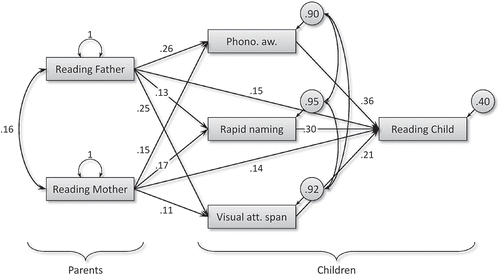Figures & data
FIGURE 1 Possible causal relationships between reading ability of parents on the one hand and reading-related cognitive skills and reading ability of children on the other.

TABLE 1 Descriptive Statistics
TABLE 2 Parent–Child Correlations for Two Age Bands
FIGURE 2 Saturated structural equation model with standardized parameter estimates. Note. All parameter estimates are significant (ps < .03) except for VAS on mother’s reading. Correlations between unexplained variances in cognitive skills are omitted from the figure; values are PA-RAN .34, PA-VAS .37, RAN-VAS .26. Reading = word-level reading fluency; PA = phonological awareness; RAN = rapid naming; VAS = visual attention span.

FIGURE 3 Final structural equation model with standardized parameter estimates. Note. Arrows intersected by equal shapes are constrained to be equal. All path estimates have p values < .001; the parents’ reading correlation has p = .019. Correlations between unexplained variances in cognitive skills are omitted from the figure; values are: PA-RAN .33, PA-VAS .38, RAN-VAS .26. The model fit is χ2(4) = 3.25, p = .52; RMSEA < .001; N = 373 families (939 individuals). Reading = word-level reading fluency; PA = phonological awareness; RAN = rapid naming; VAS = visual attention span.

TABLE A1 Level of Education on a 5-Point Scale, Including Percentages for the FIOLA Sample and the Dutch Population of 35- to 55-Year-Olds

